When “White Christmas” was written in 1942, Irving Berlin had good reason to yearn for the snows “just like the ones [he] used to know.” Measurements of the white stuff in Manhattan had been slumping since the late 1800s, with the 15-year rolling median of 35.5 inches from 1884 falling to a mere 15.6 inches by the year of the song’s release, and then plunging further, to only 13.4 inches in 1998-99. What has followed is nothing short of a holiday miracle: in the subsequent eighteen years, snowfall has increased in an unprecedented fashion across much of the Northeastern seaboard, with the rolling median at Central Park now reaching 40 inches. With New York City’s median recent snowfalls tripling in a matter of two decades and surpassing totals at the end of the Little Ice Age at the same time that temperatures have continued to warm, it is time for the city’s inhabitants to ask why exactly this is happening, and consider the practical implications that a rapidly-shifting climate will have on real estate.
The statistics get even weirder when considering that mounting snowfall totals come in spite of temperatures that continue to increase in general. The City now regularly contends for its hottest-month-on-record, and while strikingly negative anomalies like February of 2015 still occur, the overall trend is warmer. While this adheres to most climactic predictions, the discord between snowfall and temperatures show that general vague statements about what is coming next fail to describe the more dramatic changes actually occurring on the ground, which are seemingly impossible to predict based on current modeling.
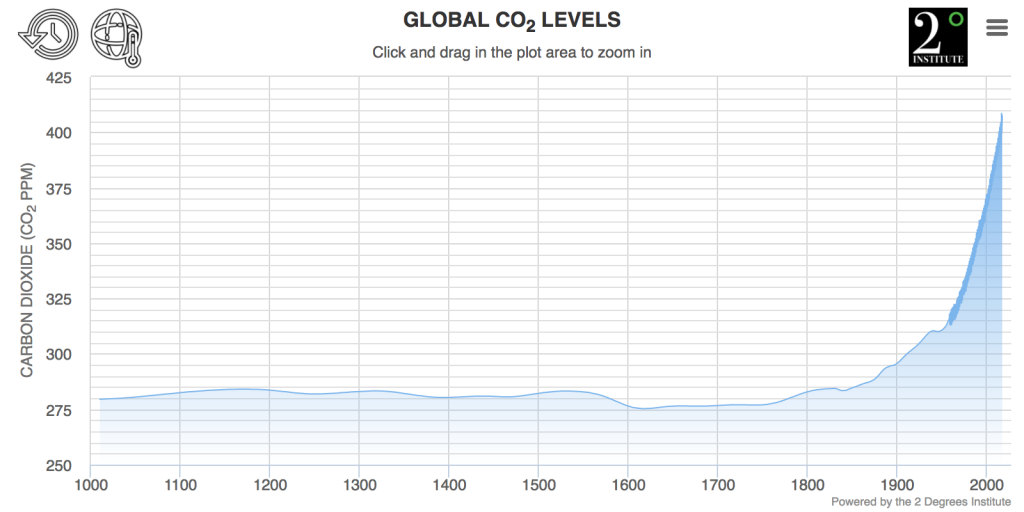
Approximate Global Carbon Dioxide levels over the past few centuries, data from CO2 Levels
New York City’s NIMBY populations generally fashion themselves among the more liberal members of society at large. However, the politics of preservation are about to run into headwinds that are rapidly worsening, and now, concrete measurements of indisputable changes in local climatology are making it obvious that the 35% increase in atmospheric Carbon Dioxide since the writing of “White Christmas” is increasingly impacting the lives of the Five Boroughs’ inhabitants. If that were not enough, national losses from disasters influenced by climate change or otherwise surpassing $400 billion in 2017, or approximately four percent of the United States’ gross domestic product, with Harvey’s total alone falling just short of $200 billion. It is increasingly clear, now more than ever, that New Yorkers must choose between saving the crumbling past, or preparing for a difficult but potentially salvageable future.
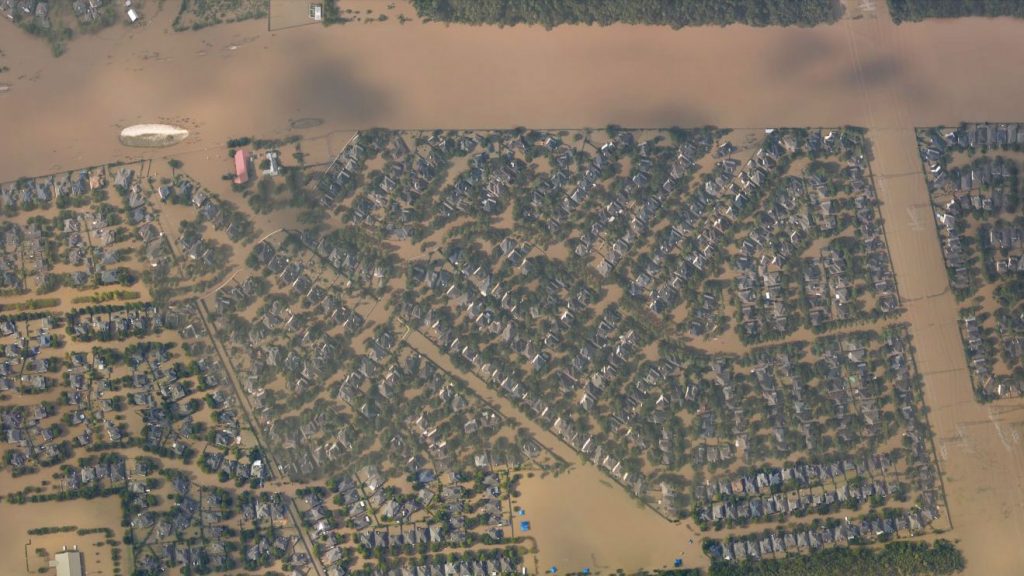
Hurricane Harvey’s flooding in Houston, image by NOAA
On the surface, the efforts of Jane Jacobs had enduring positive impacts. But climate change will ultimately prove these to have been futile, and it is time for the denizens of the West Village and elsewhere to practice what they preach when it comes to recognizing the impending effects of weather weirding. Worsening impacts have already resulted in an instance where landmark after landmark was inundated by saltwater. What comes next means that a repeal of preservationists’ spider webs of red tape is unavoidable, by politics or by nature, within the next century.
Current estimates project approximately five to six feet of sea level rise by 2100, and a worst-case of over eight feet. With that number yawning to upwards of 20 feet by 2200, it is difficult to conceive of practical impacts worsening within the short-term. But Millennials and Gen X’ers are likely to be subject to noticeable shifts in actual shorelines as the ice sheets in Greenland and Antarctica continue to collapse. And with events like Sandy already being outranked by catastrophes like Hurricanes Harvey and Maria, the wealthiest Baby Boomers who make it into the 2040s are likely to see their oceanfront property begin to wash away entirely.
Vague dates in the future have been a problem in the debate surrounding climate change, and in 2011, critics pointed to the research of Dr. James Hansen as hyperbole. But one year later, when Breezy Point burned to the ground and the West Side Highway was indeed underwater, the prediction did not seem so laughable.
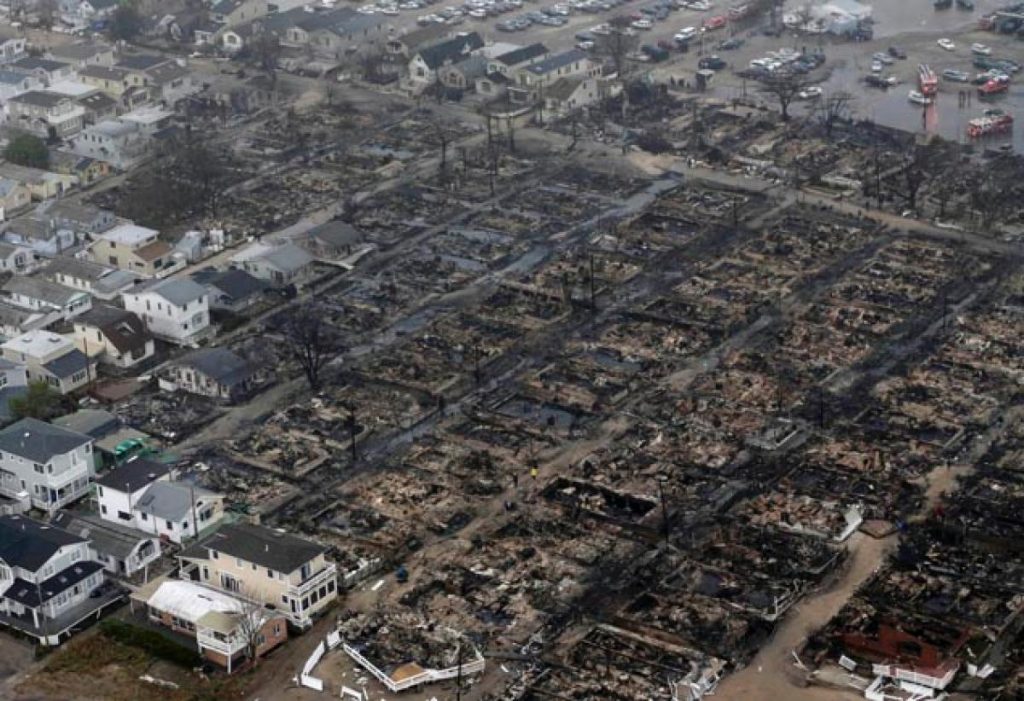
Breezy Point after Sandy, image by Mike Groll/The Associated Press
Ignorance of impending change is a breeding ground for chaos, and in this regard, it seems the local leaders of the Five Boroughs are lodging their heads further in the sand instead of recognizing that those younger than themselves are going to inherit a collection of islands that are sinking both physically and financially. And with weather-weirding already resulting in an actual climate that is increasingly foreign to what it was only twenty years ago, the potential and reality of Black Swan events like Hurricane Sandy have illuminated a system that will fail, and probably soon.
Instead of recognizing the changes that have already occurred and the worsening circumstances in the city’s near-future, efforts have focused on half-baked ideas for hunkering down. For multiple reasons, this tact is not the answer, and will only harm the ability of the Five Boroughs to adequately address oncoming urban distress in full.
The most obvious example is the impending L Train shutdown. Even worse, in the months since that was announced, the general system-wide service across most every line of the MTA has, by all accounts, deteriorated substantially. Even more egregious was a proposal by think-tank elites suggesting the end of 24-hour service. An expose released by the New York Times yesterday further highlights how outrageously offensive the conduct of the MTA and Governor Cuomo have become to the everyday lives of New Yorkers.
The reality on the ground is that the entire subway system is basically falling apart. Sandy’s mark will extend upwards of a decade past its original landfall. And it should seem obvious that temporary shutdowns will do little to mitigate the potential of future events which could inundate even larger percentages of the underground subway system.
As if the deteriorating situation regarding public transit were not bad enough, conversations to build a wall have gone nowhere.
This is where the politics of preservation begin to look particularly foolish. While increasing snowfall totals aren’t inherently dangerous to the blocks of the West Village at their current levels, rapidly rising oceans most certainly are a threat. But building a wall with public dollars around neighborhoods that are mostly composed of privately owned mansions and multi-million-dollar condominiums will create additional problems of inequality, where tax dollars from the city’s most vulnerable are used to subsidize the protection of its wealthiest denizens.
The reality of the upcoming century is that there will have to be massive infrastructure spending to protect the densest coastal real estate from inundations of increasing depth and frequency. The other side of that coin is that much of the urbanized land that will demand protection within Manhattan is currently under-built relative to existing transit infrastructure. Equally important, much of it is occupied by wealthy NIMBYs who scream about preservation and preach about climate change, while failing to realize that in low-lying historic areas, climate change will ultimately cause all efforts to preserve the built environment to be futile, without access to public infrastructure dollars.
Consequently, 2018 is the year New Yorkers must ask themselves whether they want to personally subsidize the wealthy NIMBY fetish for the past through their own tax dollars. Or, we can create a plan for moving forward that addresses the inevitable, and neighborhoods like the West Village can finally take their share of the burden of change affecting all inhabitants of the Five Boroughs.
If public dollars are to be spent on saving the coastline and real estate within whatever sea walls are eventually built, it is morally unacceptable to leave the West Village and similarly well-off bastions of NIMBYism in-stasis when neighborhoods like Coney Island are likely to be left to the waves.
Repositioning the most historically valuable buildings on higher ground is one course of action, and preserving facades is another. But, ultimately, most or all of these neighborhoods will have to be razed. If they are to be protected by publicly-funded seawalls, the blocks of the West Village must be partially or entirely redeveloped with housing that actually matches the potential of existing infrastructure.
While the West Village is the worst example of NIMBYism colliding with climate change, areas like the Lower East Side, Tribeca, and SoHo will also have to be re-thought, if continued human habitation is a goal.
The alternative is a crumbling city where more and more money is spent on maintaining a series of tunnels and empty historic buildings that do nothing to help the vast majority of New Yorkers. Even though sea walls may ultimately be futile in the upcoming centuries, the time bought by wise investments in public infrastructure, both under the city and around it, could be sufficient to allow retrenchment. But this will not be possible with the current urban configuration of many coastal neighborhoods.
A fetish for the past is only partially to blame for the current predicament facing the Five Boroughs. But 2,000 years of evidence shows, ironically, that the only way to preserve non-monumental urban architecture is through natural calamities at the cost of human populations. In fact, the only substantive relics of Rome’s urban legacy are Pompeii and Herculaneum, where inhabitants and structures alike were encased in pyroclastic floes. Saltwater isn’t nearly as structurally forgiving, and in any case, the survival of buildings in both towns came at the cost of their entire citizenry.
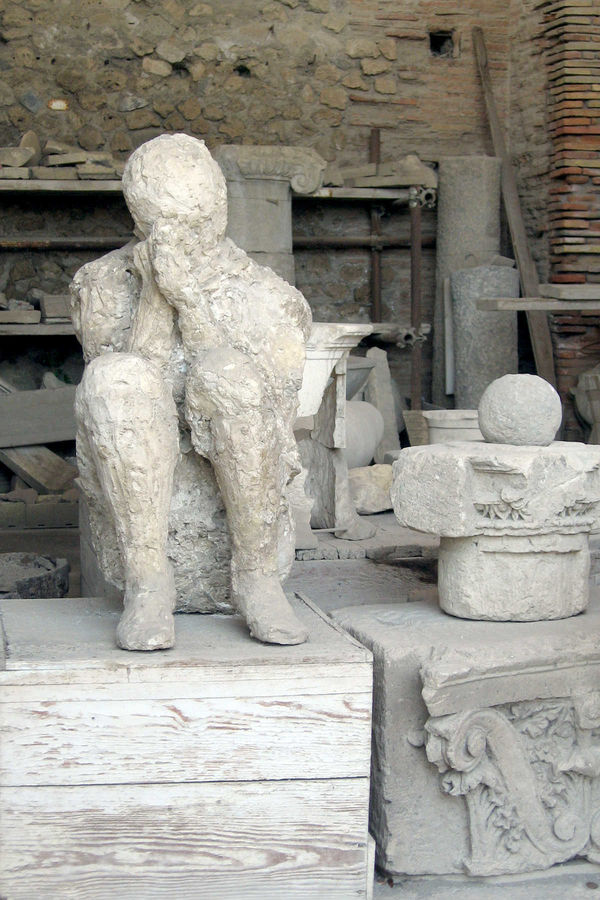
Vesuvius victim, photo by Andrew Wakeling
Rising snowfall totals are but one unexpected consequence of the changing climate. However, they are concrete evidence that change is indeed occurring. Combined with mounting losses across the rest of the United States, it should be obvious to New Yorkers that the Five Boroughs will be no exception in an environment beset by Harveys, Katrinas, Marias, and Sandys. And if anything has been proven by the storms that have already occurred, it is that an unwillingness to acknowledge worsening change is the cornerstone to failure.
Subscribe to YIMBY’s daily e-mail
Follow YIMBYgram for real-time photo updates
Like YIMBY on Facebook
Follow YIMBY’s Twitter for the latest in YIMBYnews

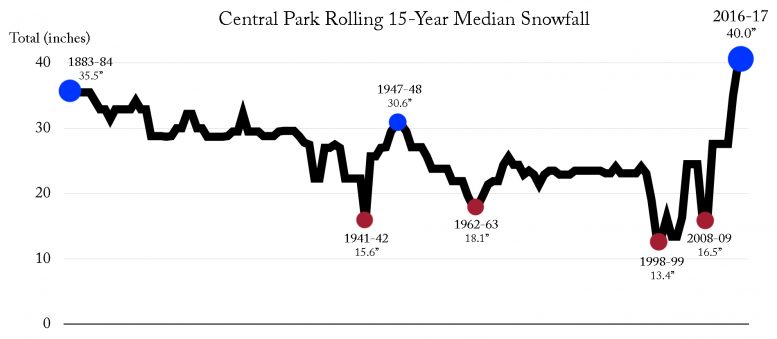




Please pardon me for using your space: I love volcano, but sometimes its hot not welcome human. (How about track in the center from base to top on a 30-story?)
Eloquent and well-argued essay!
scare tactics based on faulty logic. the myth of catastrophic shifts in the climate depends on theories which have utterly failed to be predictive for almost 40 years. the data that shows “hottest year on record” is rather suspect, based on the record, the data, AND the interpretation. All of this is available to learn for anyone who cares to look behind the curtain. This is important because expending enormous resources on pointless measures prevents us from taking much more useful measures at the same time.
Regarding the MTA, it’s obvious to any competent person that mismanagement and idiotic union rules are the real cause of the problems we have seen. If you create a policy that specifically degrades service you can’t exactly be surprised when you end up with degraded service, can you? If you treat infrastructure maintenance and capital projects as labor programs instead of urgent, priority jobs you’ll get 10-year timeframes for 1-year jobs.
Stop accepting the cures offered to you by those who have created the problem in the first place. They are either ignorant or lying. In either case, they are wrong and it is extraordinarily easy to demonstrate.
Did you miss the data from Central Park showing the dramatic increase in snowfall?? This is not subjective but obviously climate deniers know no bounds when it comes to ignorance and stupidity…
I like your solution: Bury your head in the sand!
Interesting piece that tries to link prepping for climate change to the need to destroy the historic fabric of Greenwich Village, but logically, I don’t see why the solution to climate change is tearing down one of the few intact early 20th century streetscapes in the city in the name of “increased density” a.k.a. more graceless Shanghai-style steel and glass structures whose main appeal seem to be that they are designed by a “starchitect” and their apartments mainly get bought up by the world’s oligarchs and one-percenters. Oh, and let’s not forget that new development fetishized by this blog mainly enriches real estate developers and the REBNY crowd.
We don’t really know what the world of climate change will look like, and it is highly debatable that those high rise dormitories fetishized by this blog won’t also suffer climtate change related problems as well. Many environmentalists argue that new investment in buildings or infrastructure lining the city’s shorelines is likely a bad idea.
New development enriches “the REBNY crowd” because small-time development has been completely abandoned in NYC, the kind that gave rise to the West Village in the first place (as well as actual affordability).
The point is that the WV will be obliterated by rising sea levels within 100-150 years anyways — if we are going to put up walls around it, it would be best to move what is most valuable to high ground, while putting the existing excellent transit infrastructure to good use for substantially more density, which it can definitely support. The goal is keeping the neighborhood viable, through whatever means.
We certainly do not know what the world of CC will look like, however, we are beginning to get inklings… and as the snowfall data shows, what we are *already* seeing is very dramatic, unpredicted, and probably terrible.
I would agree that in general new infra/buildings along shorelines are a bad idea, but Manhattan is a special case that has sufficient extant density to demand retrenchment before abandonment… densifying the WV/other historic areas with good infra to support displaced populations within NYC/elsewhere is a means to an end. But feel free to disagree.
Where did they get the CO2 levels from. They did not do tests before the early 1900’s.
There is phony science on both sides of the warming issue.
The CO2 levels came from ice core measurements, which were not done “before the early 1900s” (they have been done since the 1950s) but can measure CO2 levels to about 800,000 BC.
“The good thing about science is that it’s true whether or not you believe in it.”—Neil deGrasse Tyson
The verse of “White Christmas” reads:
Berlin was not referring to a dearth of snow in New York City.
Exactly why, in your view, is it happening?
You are correct RE: Beverly Hills, though it did also apply to NYC,
I am not sure why it is happening. There are multiple major happenings occurring globally. The two most significant/likely reasons, IMO, are 1) decreasing sea ice extent in the Arctic Ocean, which allows more moisture transport/earlier snowfall in the high latitudes, and 2) Greenland hitting a tipping point where increasing precipitation and melt is destabilizing the North Atlantic.
NASA has some excellent maps thanks to GODAS. I suggest visiting the link and viewing “sea level” anomalies by month and year. There were blips through the 80s and 90s but since the El Nino in 2009-10, the far NW NATL next to the NE Seaboard has been warming and rising on a consistent/annual basis. Coincidence? Perhaps, but it seems very odd that it coincides perfectly with the dramatic uptick in consistent heavy snowfalls across the NE US.
http://www.cpc.ncep.noaa.gov/products/GODAS/mnth_movie.shtml
Show a simple scatter plot of annual snowfall totals in Central Park since 1870. I dare you.
Interesting article.
But you seem to worry most about Manhattan and its “landmarks” (granted, it’s our economic engine) than the millions of flesh and blood everyday people living in low lying areas of Brooklyn aend Queens, who will be most risk at risk , and whose lives may be more highly impacted – and sooner.
Perhaps the modern day equivalent of the frozen-in-time Vesuvius victim will be a climate change denier, drowned, as he or she sticks their head into the sand of his beachhouse in the Hamptons.
Still, I was expecting more of an answer to the question posed in terms of what will happen in the near future (i,e, Why New York City’s Rapidly Rising Snowfall Totals Are No Holiday Miracle). In other words, will NYC and the surrounding area of the Northeast become a winter wintertime blizzzard battleground between the warm and the cold –fueled by the increasing warmth and mositure availablity? Not to mentioned summer and fall super storms like Sandy. After all just a year ago we had our all-time greatest snowfall from a single storm, despite a fairly average winter in terms of temperature. Or will we slide back to a no snow regme in NYC as temperatures continue to increase year-round?
I guess the answer to that, at least for the short term, is literally “up in the air”.
It seems likelt tha our children and their children will suffer from what we have wrought …from both our actions and our inactions.
I think the answer is yes to your last suggestion. While snowfall could decrease, another ten years of measurements should provide clues as to the trajectory over the next century — i.e., if numbers start trending towards 50″+, snow could join future Sandys as an actual threat to the city. The glaciers did terminate on Long Island during the last Ice Age…
(Also: while technically it is just about impossible to say, I do believe snowfall is likely to continue increasing. Again, while impossible to ascertain, I also believe that Greenland has reached a tipping point where both melt *and* precipitation have increased to the point where runoff is disrupting the North Atlantic more and more substantially. The reservoir of increasingly warm water off the NE seaboard is probably to blame for this rapid shift in NYC’s climate, and its origins start in the disruption of the AMOC).
Check this link, and click “sea level” then animate monthly or yearly. The trend off the NE coincides with the uptick beginning this millennium in NYC’s snowfalls. And it is now worsening annually.
http://www.cpc.ncep.noaa.gov/products/GODAS/mnth_movie.shtml
You are also correct re: Hamptons/etc — just look at the comments under this article…
So we should sell out the present for what might happen 100 years from now. Sorry, I’m not buying it. Yes, climate change is real but this scare peice is suggesting razing some of our greatest neighborhoods to build dense valuable housing that would be “worth” protecting.
This article is nonsense—just unreasoning scare tactics. The idea that greater snowfalls in the past few years are reason to start demolishing Greenwich Village would be hilarious if you weren’t trying to be serious. But thanks for including the destruction of Pompeii, because that clinched the silliness.
If you are so concerned with what the people in manhattan may be up against, why are you not pushing to develop more density housing in the upper parts of the east and west side and in the Bronx? Oh, I forgot, not the same obscene kind of land value that you can glom onto right now.
Dumbest pitch for a land grab I’ve seen so far.
The West Village/etc have some of the best existing transit infrastructure in the city. Those neighborhoods you mention should also be fair game.
My comment has been in moderation for more than 24 hours.
Is there a reason for it?
It is approved!
That fact that any neighborhood is “fair game” for REBNY is exactly why NYC is full of empty oligarch apartments, tourists, and 3rd generation New Yorkers like myself are being forced out by prices.